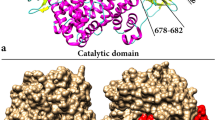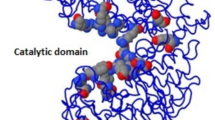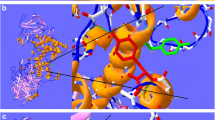Abstract
We used a combination of protein engineering and spectroscopic methods to investigate the effect of a long length loop on the conformational stability and activity of chondroitinase ABC I. This study involves manipulation of interactions around Asp689 as a key residue in the central region of the loop containing residues 681–695 located at C-terminal domain of the enzyme. According to the equilibrium unfolding experiments and considering thermodynamic m value and ΔG(H2O), we found that the folded state of H700N, L701T, and H700N/L701T are more compact relative to the folded state of wild-type protein and they become stabilized upon mutation. However, the compactness and stability of other variants are less than those of wild-type protein. According to enzyme activity measurements, we found that the catalytic efficiency of structurally stabilized variants is decreased, while that of destabilized mutants is improved.





Similar content being viewed by others
References
Regad, L., Martin, J., Nuel, G., & Camproux, A. C. (2010). Mining protein loops using a structural alphabet and statistical exceptionality. BMC Bioinformatics, 11, 75.
Shehu, A., & Kavraki, L. E. (2012). Modeling structures and motions of loops in protein molecules. Entropy, 14(2), 252–290.
Shehu, A., Clementi, C., & Kavraki, L. E. (2006). Modeling protein conformational ensembles: From missing loops to equilibrium fluctuations. Proteins, 65(1), 164–179.
Rufino, S. D., Donate, L. E., Canard, L. H., & Blundell, T. L. (1997). Predicting the conformational class of short and medium size loops connecting regular secondary structures: Application to comparative modelling. Journal of Molecular Biology, 267(2), 352–367.
Tosatto, S. C. E., Bindewald, E., Hesser, J., & Männer, R. (2002). A divide and conquer approach to fast loop modeling. Protein Engineering, 15(4), 279–286.
Du, P., Andrec, M., & Levy, R. M. (2003). Have we seen all structures corresponding to short protein fragments in the Protein Data Bank? An update. Protein Engineering, 16(6), 407–414.
Zhou, H. X. (2001). Loops in proteins can be modeled as worm-like chains. Journal of Physical Chemistry B, 105(29), 6763–6766.
Bartalesi, I., Bertini, I., Di Rocco, G., Ranieri, A., Rosato, A., Vanarotti, M., et al. (2004). Protein stability and mutations in the axial methionine loop of a minimal cytochrome c. JBIC Journal of Biological Inorganic Chemistry, 9(5), 600–608.
Kurchan, E., Roder, H., & Bowler, B. E. (2005). Kinetics of loop formation and breakage in the denatured state of iso-1-cytochrome c. Journal of Molecular Biology, 353(3), 730–743.
Hynes, T. R., Kautz, R. A., Goodman, M. A., Gill, J. F., & Fox, R. O. (1989). Transfer of a beta-turn structure to a new protein context. Nature, 339, 73–76.
Murphy, M. E., Fetrow, J. S., Burton, R. E., & Brayer, G. D. (1993). The structure and function of omega loop A replacements in cytochrome c. Protein Science, 2, 1429–1440.
Mulligan-Pullyblank, P., Spitzer, J. S., Gilden, B. M., & Fetrow, J. S. (1996). Loop replacement and random mutagenesis of omega-loop D, residues 70-84, in iso-1-cytochrome c. Journal of Biological Chemistry, 271, 8633–8645.
Nagi, A. D., & Regan, L. (1997). An inverse correlation between loop length and stability in a four-helix-bundle protein. Folding and Design, 2(1), 67–75.
Koga, N., Tatsumi-Koga, R., Liu, G., Xiao, R., Acton, T. B., Montelione, G. T., & Baker, D. (2012). Principles for designing ideal protein structures. Nature, 491, 222–227.
Höcker, B. (2012). Structural biology: A toolbox for protein design. Nature, 491, 204–205.
Balasco, N., Esposito, L., De Simone, A., & Vitagliano, L. (2013). FOR the RECORD: Role of loops connecting secondary structure elements in the stabilization of proteins isolated from thermophilic organisms. Protein Science, 22, 1016–1023.
Huang, W., Lunin, V. V., Li, Y., Suzuki, S., Sugiura, N., Miyazono, H., & Cygler, M. (2003). Crystal structure of Proteus vulgaris chondroitin sulfate ABC lyase I at 1.9 Å resolution. Journal of Molecular Biology, 328(3), 623–634.
Sandvig, A., Berry, M., Barrett, L. B., Butt, A., & Logan, A. (2004). Myelin-, reactive glia-, and scar-derived CNS axon growth inhibitors: Expression, receptor signaling, and correlation with axon regeneration. Glia, 46(3), 225–251.
Matsui, F., & Oohira, A. (2004). Proteoglycans and injury of the central nervous system. Congenital Anomalies, 44(4), 181–188.
Crespo, D., Asher, R. A., Lin, R., Rhodes, K. E., & Fawcett, J. W. (2007). How does chondroitinase promote functional recovery in the damaged CNS? Experimental Neurology, 206(2), 159–171.
Bradbury, E. J., Moon, L. D. F., Popat, R. J., King, V. R., Bennett, G. S., Patel, P. N., et al. (2002). Chondroitinase ABC promotes functional recovery after spinal cord injury. Nature, 416(6881), 636–640.
Ikegami, T., Nakamura, M., Yamane, J., Katoh, H., Okada, S., Iwanami, A., et al. (2005). Chondroitinase ABC combined with neural stem/progenitor cell transplantation enhances graft cell migration and outgrowth of growth associated protein 43 positive fibers after rat spinal cord injury. European Journal of Neuroscience, 22, 3036–3046.
Nazari-Robati, M., Khajeh, Kh, Aminian, M., Fathi-Roudsari, M., & Golestani, A. (2012). Co-solvent mediated thermal stabilization of chondroitinase ABC I form Proteus vulgaris. International Journal of Biological Macromolecules, 50(3), 487–492.
Nazari-Robati, M., Khajeh, Kh, Aminian, M., Mollania, N., & Golestani, A. (2013). Enhancement of thermal stability of chondroitinase ABC I by site-directed mutagenesis: An insight from Ramachandran plot. BBA, 1834, 479–486.
Fisher, C. L., & Pei, G. K. (1997). Modification of a PCR-based site-directed mutagenesis method. BioTechniques, 23, 570–574.
Bradford, M. M. (1976). A rapid and sensitive method for the quantitation of microgram quantities of protein utilizing the principle of protein-dye binding. Analytical Biochemistry, 72, 248–254.
Yamagata, T., Saito, H., Habuchi, O., & Suzuki, S. (1968). Purification and properties of bacterial chondroitinases and chondrosulfatases. Journal of Biological Chemistry, 243(7), 1523–1535.
Tomazic, S. J., & Klibanov, A. M. (1988). Mechanisms of irreversible thermal inactivation of Bacillus alpha-amylases. Journal of Biological Chemistry, 263(7), 3086–3091.
Santoro, M. M., & Bolen, D. W. (1988). Unfolding free energy changes determined by the linear extrapolation method. 1. Unfolding of phenylmethanesulfonyl alpha-chymotrypsin using different denaturants. Biochemistry, 27, 8063–8068.
Pace, C. N. (1986). Determination and analysis of urea and guanidine hydrochloride denaturation curves. Methods in Enzymology, 131, 266–280.
Tina, K. G., Bhadra, R., & Srinivasan, N. (2007). PIC: Protein Interactions Calculator. Nucleic Acids Research, 35(Web Server Issue), W473–W476.
Das, R., & Baker, D. (2008). Macromolecular modeling with rosetta. Annual Review of Biochemistry, 77, 363–382.
Smith, C. A., & Kortemme, T. (2008). Backrub-like backbone simulation recapitulates natural protein conformational variability and improves mutant side-chain prediction. Journal of Molecular Biology, 380, 742–756.
Myers, J. K., Pace, C. N., & Scholtz, J. M. (1995). Denaturant m values and heat capacity changes: Relation to changes in accessible surface areas of protein unfolding. Protein Science, 4, 2138–2148.
Acknowledgments
Financial support for this work was provided by research council of Tarbiat Modares University.
Conflict of interest
The authors have declared no conflict of interest.
Author information
Authors and Affiliations
Corresponding author
Rights and permissions
About this article
Cite this article
Akram Shirdel, S., Khalifeh, K., Golestani, A. et al. Critical Role of a Loop at C-Terminal Domain on the Conformational Stability and Catalytic Efficiency of Chondroitinase ABC I. Mol Biotechnol 57, 727–734 (2015). https://doi.org/10.1007/s12033-015-9864-3
Published:
Issue Date:
DOI: https://doi.org/10.1007/s12033-015-9864-3




